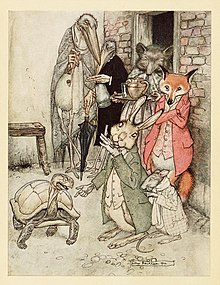The turtle and the hare (fable)
The turtle and the hare is a fable written by the ancient Greek fable poet Aesop . In the Perry Index , a directory of Aesop's fables, the fable has the number 226.
action
In the fable there is a hare mocking a slow turtle . The turtle then challenges the rabbit to a race. The hare is quickly far ahead of the turtle. Confident that he will win the race, the rabbit decides to take a nap during the race. But when the rabbit wakes up, he finds out that the turtle, which was walking slowly but steadily, had won the race.
A later version of the fable, which appeared in La Fontaine's Fables , is almost exactly the same as Aesop's version, although the fable is more elaborate.
Interpretations
As in many of Aesop's other fables, the moral of the fable is ambiguous. In ancient times, the hare's foolish arrogance was emphasized. In an old Greek letter it says: Many people have great skills which they waste by being lazy; again, one can assert oneself with perseverance, prudence and determination. Otto van Veen recommended in Emblemata Amorum (1608) "Eile mit Weile" (Latin: festina lente ), which is based on the fable. In one picture there is a young Eros in a landscape. He points to the turtle as it overtakes the sleeping rabbit. Under the picture it says "Perseverance wins". Later interpretations of the fable also claimed that the doctrine of the fable was "hurry with a while" (e.g. Samuel Croxall ), or linked the fable and the quotation from the Bible "that walking does not help to be fast ..." ( Ecclesiastes 9.11).
In another interpretation, the turtle was praised as brave for resisting the rabbit's mockery.
From the 19th century the fable was presented in a satirical way. The satirical book The Fables of Aesop translated into Human Nature (1857) (Engl .: The fables of Aesop into human nature translated ) by Charles H. Bennett presented the hare is a craftsman who suffered from a capitalist private entrepreneurs. Another version wrote Lord Dunsany in the book The True History of the Tortoise and the Hare (1915) (English: The real history of the hare and the turtle ). In this story, the rabbit realizes how stupid the challenge is and turns it down. The stubborn turtle runs to the finish line anyway and was declared faster. Yet, as Dunsany wrote, "This version of the race is well known because few witnesses of the race survived the forest fire that broke out immediately after the race. The fire was carried into the forest by a strong wind. The hare, the turtle and Several other animals saw the fire from a high, bare hill at the edge of the forest. In an emergency they sat down to choose a messenger who would warn the animals in the forest about the fire. They decided on the turtle. "
